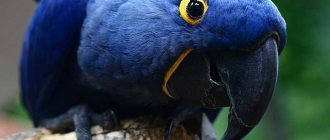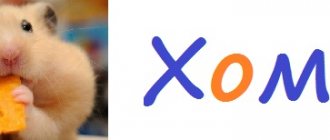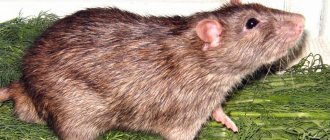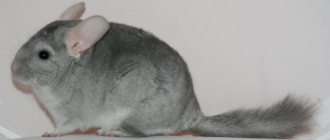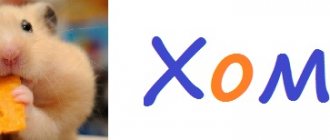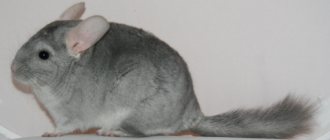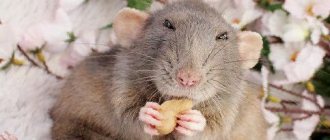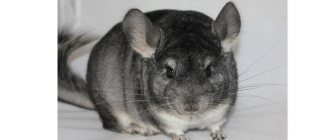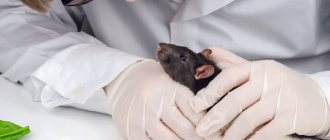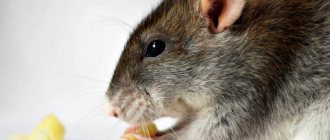Let's look at the breeds of rats with photographs and names, and make sure that the fixed mutations are very diverse, for every taste.
Types of rats by body type
There are 3 types of rats based on their build type. Standard are rodents of a familiar species. They have an elongated body, they have a long bare tail of about 20 cm. Like their wild relatives, such rats can weigh up to 0.5 kg and reach 24 cm in length. Rodents have round ears on top of their heads and an elongated snout. The fur of the animals lies tightly to the body, it is smooth and shiny.
The most common type of rats of the standard breed
Dumbo - another variety differs from the standard in ears. They are located not on the top of the head, but on the sides of the head, like the elephant of the same name in the cartoon. Dambo ears are large and open; a slight bend in the upper part of the auricle is allowed. Due to the position of the ears, the head appears wider. The back of the head of these rodents may be slightly convex. The rear of the rat is wider, so the body shape may be slightly pear-shaped.
The round ears of the domestic rat of the Dumbo species give it a special charm
The Manx, a rat without a tail, is classified as a separate species. A rodent needs its tail to cool its body and balance itself. A high proportion of anuran rats have problems with their hind legs and genitourinary system. The birth of cubs is associated with the risk of having a non-viable litter. Sometimes, under the guise of Manx cats, sellers sell ordinary baby rats with their tails amputated after birth. The body of the tailless rat is not elongated, like that of the standards, but in the shape of a pear.
The Manx breed of domestic rats is fraught with many unpleasant surprises.
Important: The tailless rat is a potential handicap, and self-respecting communities do not seek to support this genetic lineage.
Markings for this color
A husky rat can only be one of two available markings:
- Berkshire Husky.
- Banded Husky.
The Berkshire Husky is a coat type marking with a white belly and colored rat back. The head, like the back, is also colored.
Banded Husky is a "hood" type marking where the animal's head, chest and shoulders are evenly colored. The exception is Blaze. From the so-called hood, a strip of dyed wool runs along the back. In this marking, such a stripe is very wide.
Breeds of domestic rats by coat type
Domestic rodents are also divided according to their coat type. The fur of animals can be short, long, curly, etc. There are bald pets and rodents with bald spots in their coats, and this is the norm.
Standard
Rats with Standard coats have short, smooth, glossy fur.
The “Standard” coat type is smooth and short hair in rats.
Longhair
Long-haired varieties of rats differ from the standard in having longer hair.
Long-haired rat
Sphynx (hairless) rats
Sphinxes must be completely hairless. Down is allowed on the head, paws and groin area. Typically, rodents have pink folded skin, but there are individuals with dark spots. The vibrissae of this variety are shorter than those of the standards and can curl.
The Sphynx breed of decorative rats must be protected from both cold and overheating
It is more difficult to maintain such an animal than its “dressed” relatives. Bare skin is sensitive to changes in temperature and humidity. The defenseless skin can be injured by the claws of the pet itself. By nature, sphinxes are gentle and sensitive, they need contact with their adored owner.
Downy (fuzz)
Downy rats look similar to sphinxes, but they have the hairy rat gene at work. The skin of fuzzes is covered with down - there are no guard hairs. The hairs are longer on the face and lower part of the body. Vibrissae short and twisted. Unlike sphinxes, downy animals are valued for more “dressed” individuals. Fazzas are more resistant to external factors than sphinxes and are easier to breed. However, thin fluff does not always protect against overheating or cooling, so pets need special attention.
The fuzz variety of rats has a delicate fluff - not a very full-fledged “clothing”
Satin (satin)
Satin or satin rats have thin, shiny fur. The shine of the fur coat makes the animals attractive. Due to the thin fur, the fur hairs appear visually longer. Satins can have short hair, like standards. Long hair does not define this variety: not every long-haired rat is a satin.
The satin or satin rat is covered with fine, shiny fur
Rex (curly)
The fur coat of the Rex rat is similar to the fur of the cat breed of the same name - it is tough and curly. Elastic curls do not appear immediately. In rat pups, the curls have not yet formed, and the hairs can stick out in different directions. Because of this, the kids look disheveled. According to the breed standard, the coat should be uniform, without bald spots. The animals have short curled mustaches. In other respects, Rexes are similar to Standards.
Baby rex rats sometimes look disheveled
Double Rex
Such rats are born when mom and dad are carriers of the “curly” gene. The fur of such animals is unusual. The skin has areas of fluff and hard guard hair. Another feature is molting. From childhood, rat pups lose their fur, and the skin becomes like a patchwork quilt. Areas of fur alternate with bald spots. Later, hair grows on the bald areas and falls out on the “hairy” ones. Double Rexes are not officially recognized as a species.
The Double Rex rat breed has bald spots on its skin.
Wavy or corduroy varieties of ornamental rats
Corduroy rats have curly or wavy fur. On some individuals it looks like bird feathers. Unlike Rexes, Velveteens have soft fur. This is due to fewer guard hairs. The undercoat of such rodents is thick, without bald spots. Vibrissae are long, slightly wavy, often with curled tips.
The wavy fur of the Velvetina rat variety is soft to the touch
Cute animals that look like cats
Quite recently, a rat with an interesting color was bred - Siamese. The color of this variation is very similar to the color of a Siamese cat. There is a black mask on the muzzle.
Siamese rats have a light beige coat throughout their body. The beginning of darkening is noted closer to the tail. In the front of the head, in the area of the nose and paws, they are black. There is an opinion that the darker the color, the more “pedigreed” the rat looks. Siamese pets almost always have pink eyes. However, more recently, Siamese rats with black eyes have appeared. As it turns out, a large number of animal lovers prefer individuals with dark eyes.
Breeds of decorative rats by color
It is customary to divide the colors of rats into several groups.
Homogeneous
The name of the group speaks for itself. All the hairs of the animal are the same color and are evenly colored from root to tip. Uniformly colored rodents include the following colors:
- black;
- blue in different versions;
- mink;
- platinum;
- beige;
- caramel;
- chocolate, etc.
Things like caramel and chocolate aren't even standardized. Rats come in other colors.
Ticked
Ticked colors have uneven colored hair. It is as if divided into sections painted in different colors. At the same time, the guard hairs are monochromatic. Wild rats belong to the ticked group - agouti color. At the base of the back, the hairs are dark gray, higher up there are yellow and orange shades, and the guard hairs are black.
Wild relatives of decorative rats have a ticked agouti color
Agoutis can be blue, platinum or amber. In blues, the coat changes from light gray to brown with light blue guard hairs. Platinum fades from light blue to cream. Amber has a transition from light orange to silver beige.
Among the ticked type there are also red representatives of decorative rodents.
The color of the fawn is distinguished by a bright orange color. The base of the hair is gray or blue, but then there is a rich red tint. Interspersed with silver guard hairs do not change the overall picture. The ticked group also includes different pearl colors of rodents.
Silver
Silver color is determined if the number of white - silver hairs is equal to the number of homogeneous ones. The animal's coat should sparkle. If there are few white hairs, then this effect will not occur. The end of the white hair may have a different color, this is allowed. The main thing is that the white wool is in sufficient quantity and mixed with a uniform tone to create shine.
A decorative rat is classified as silver if its skin is shiny
Combined
The color is a combination of two primary colors. The combined type includes Siamese and Himalayan colors, Burmese and Burmese colors. English version of the name Point. Darker points follow the main color.
Combined color involves a combination of 2 colors
Other colors of animals
Sometimes you can come across a completely unexpected color of an animal’s fur. They are given specific names. For example - hood color. This original color is the most common. It looks as if a dark “hood” covers the head, but the back and belly remain white. An animal with this color is born from two black parents.
New rare colors of rats are obtained as a result of mutation, completely unexpected for breeders.
Very rare, but still there are tricolored individuals. Numerous lovers of decorative rats know them under the name “mosaic”. They are considered especially valuable and rare. It is rare to find individuals with such an original color. With their specific color, they are similar to tortoiseshell cats. In addition to white, there may be spots of two other colors on the coat. It can be gray, red, or beige.
According to various sources, only two individuals of tri-colored rats are known.
Certain species of rats
There is a group of rodents of separate types.
Albinos
Albinos were bred in a laboratory: it is almost impossible to obtain them at home. In addition to white fur, they are distinguished by red eyes due to the lack of pigmentation. As laboratory animals, albinos are human-oriented. Owners believe that this breed of rat is the smartest and kindest. Rodents:
- rarely bite;
- love to play with people;
- easily master the necessary skills.
Albinos are resourceful, and a simple latch on the cage is not an obstacle for them. Animals are kind to their relatives and know how to empathize with them.
The albino rat breed can be called the most tame
This type of decorative rat lives less than its relatives, on average 1.5 years. Rodents are not very resistant to adverse natural conditions.
Odd-eyed
Animals with different eyes are a mutation that is not passed on to the next generation: the gene for odd eyes is recessive. It is possible to achieve cubs with this feature after systematic breeding work. As a rule, one eye of a rodent is pink and the other is black or ruby. The greater the contrast in eye color, the more valuable the animal. Different-eyed individuals can wear a fur coat of any color and texture.
A variety of rats - the odd-eyed one - is valued for its pronounced eye contrast
Husky
The Husky rat breed is so named for its similarity in color to a Spitz-type dog. Both rats and dogs have a characteristic mask on the face in the form of an inverted V. Rodents differ from their counterparts in that they change coat color throughout their lives. This complicates the choice of a purebred animal: it is not known what color an adult rat will become. There are two types: Badger and Banded. In one case - Banger - dark fur covers the entire back, leaving the belly light; in the other - Banded - the animal has only a dark hood. Babies are born monochromatic, and at 4-6 months they begin to fade. The breed values salt and pepper color.
Pure white spots are not acceptable. Another feature is the color of the eyes; they cannot be black. Options range from red to ruby.
A variety of decorative husky rats blooms with age
Mosaic and tricolor
It is generally accepted that calico rats do not exist, but rare cases disprove this. As a rule, there is a leading color that goes with white. In the history of rat breeding, at least twice, a breeder ended up with a rat of 3 colors.
One of the famous rats was born in 2002 in Alaska. It was a male named Solaris. He did not pass on his unique coloring to either his children or grandchildren. Another case when a tricolor girl with a champagne-colored hood with black spots was accidentally purchased at the Bird Market. She was called the Dusty Mouse or Shabu-Shabu.
One of several famous mosaic rats Shabu Shabu or Dust Mouse
Mastomys or natal rats
Mastomys have nothing to do with rats; they even belong to the Mouse family and to a separate genus of Mastomys. Scientists could not immediately decide on the family, so the rodents traveled from rats to mice. These inhabitants of Africa live next to humans. They were imported recently, so there is not much information on them. Outwardly, they are similar to both mice and rats. Rodents reach a size of 17 cm including the tail and weigh about 80 g. Thus, they are larger than a mouse, but smaller than a rat. They have a few colors: ticked agouti with black eyes and lightened argent (amber) with pink eyes. The animals are nocturnal and live in flocks. Mastomys are jumping creatures, this must be taken into account when keeping them at home.
Mastomys look like both rats and mice
Description of the animal
Rats belong to the class of mammals. Body dimensions can be up to 30 cm and weight 300 - 400 g. Animals lead a terrestrial lifestyle. In nature, there are rats that can climb trees. They live in burrows alone or as a family.
In addition to wild rats, there are also affectionate, caring domestic pets. Currently, many interesting decorative individuals have been bred. They communicate very well with people.
Among them it is possible to meet a unique animal without hair - the sphinx or, conversely, curly-haired animals. A rat can be tailless or have a flat tail and ears of different shapes.
A very interesting specimen is the Dumbo rat, whose coat colors can be gray, white or black. And the advantage is the ears. The larger they are, the more valuable the specimen.
The color of a rat is an important criterion when choosing a pet.
In China, Ancient Egypt and Japan, these animals were revered as sacred animals and lived in temples. It was believed that they could predict events.
And dessert!
What to feed a decorative rat so that it does not get sick and lives a long time, delighting its owners?! The diet should be balanced and varied:
- chicken eggs, fish, seafood, meat - only boiled,
- vegetables (legumes, cabbage, radishes and turnips are prohibited, potatoes - only boiled),
- fruits, berries - give without seeds and with caution, citrus fruits - prohibited,
- dairy products - sour cream, milk and condensed milk are prohibited, it is better to please your pet with fermented milk treats,
- Store-bought sweets, baked goods, lard, sausages are prohibited to give to decorative rats.
Feed your pet 3-4 times a day if it is a teenager. For adult rats, two feedings per day are sufficient. Be sure to remove any leftover food from the cage to prevent it from spoiling. Make sure there is clean water in the drinking bowl every day.
Decorative rats are becoming increasingly popular in the ranking of pets: smart, active, affectionate, sociable - interesting and easy to keep, loyal and easily bond with the owner.
Features of keeping a Rex at home
For the normal development of a curly-haired individual, spacious housing is necessary. She needs a place for outdoor games; cramped living conditions are contraindicated for this breed. This species is socially active and it would be better to take more than one individual at once. If this is not possible, then be sure to equip your pet with its habitat.
Buy:
- House;
- Swing;
- Various manholes;
- Items for entertainment.
Feeding a rex, like any domestic rat, should be balanced. Despite the omnivorous nature of these rats, it is necessary to include ready-made fortified foods and cereals in the diet.
Caring for your pet includes cleaning the cage and feeding it twice a day. Meals should be in unequal portions: most should be left for the evening.
Twice a month it is necessary to disinfect your pet’s home.
Of course, there must be fresh drinking water in the cage.
By observing these simple conditions, your beloved Rex will always delight you with funny games!
Predators in nature
As a rule, in urban areas you can most often find ordinary rats. They may have a gray, sometimes black skin color. The colors of rats in nature range from grayish to red. Sometimes you can find a brown rodent.
The most common types of rat colors in nature:
- Gray rat. Young animals have gray fur. When they mature, they acquire a reddish tint. On the abdomen, white hairs have a dark base.
- Black rat. On the back, the color of the skin has a greenish tint. The belly has dark gray or ash-colored hairs.
- Small rat. It has a brown skin color.
In central Russia, there are mostly two types of rats: black and gray.
